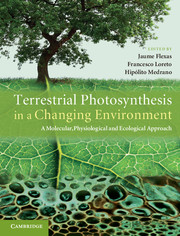 Terrestrial Photosynthesis in a Changing Environment
Terrestrial Photosynthesis in a Changing Environment Book contents
- Frontmatter
- Contents
- List of contributors
- Preface
- Acknowledgements
- List of abbreviations
- 1 Terrestrial photosynthesis in a changing environment
- Part I Photosynthesis
- 2 Biochemistry and photochemistry of terrestrial photosynthesis: a synopsis
- 3 Photosynthetic regulation
- 4 Interactions between photosynthesis and day respiration
- 5 The ecophysiology and global biology of C4 photosynthesis
- 6 Ecophysiology of CAM photosynthesis
- 7 Special photosynthetic adaptations
- 8 Models of photosynthesis
- Part II Measuring photosynthesis
- Part III Photosynthetic response to single environmental factors
- Part IV Photosynthesis in time
- Part V Photosynthesis in space
- Part VI Photosynthesis in a global context
- References
- Index
6 - Ecophysiology of CAM photosynthesis
Published online by Cambridge University Press: 05 March 2013
- Frontmatter
- Contents
- List of contributors
- Preface
- Acknowledgements
- List of abbreviations
- 1 Terrestrial photosynthesis in a changing environment
- Part I Photosynthesis
- 2 Biochemistry and photochemistry of terrestrial photosynthesis: a synopsis
- 3 Photosynthetic regulation
- 4 Interactions between photosynthesis and day respiration
- 5 The ecophysiology and global biology of C4 photosynthesis
- 6 Ecophysiology of CAM photosynthesis
- 7 Special photosynthetic adaptations
- 8 Models of photosynthesis
- Part II Measuring photosynthesis
- Part III Photosynthetic response to single environmental factors
- Part IV Photosynthesis in time
- Part V Photosynthesis in space
- Part VI Photosynthesis in a global context
- References
- Index
Summary
Crassulacean-Acid Metabolism is a Specific Mode of Photosynthesis
Essentially a loop of CO2 flow via organic acids, mainly malate, is switched before assimilation of CO2 in the Calvin cycle of C3 photosynthesis (see Chapter 2). This allows fixation of CO2 during darkness in the night. The nocturnally fixed CO2 is transiently stored in the form of organic acids in the cell-sap vacuole. It is remobilised again during the day and assimilated in the light (Fig. 6.1). In the evolution of vascular plants CAM has arisen polyphyletically, i.e., independently many times. In all the branches of the evolutionary tree of vascular plants, beginning with the pteridophyta, we find taxa performing CAM (Fig. 6.2). Polyphyletic evolution of CAM not only occurred between higher taxa such as subclasses and families (Fig. 6.2), but also within families and subfamilies and even within genera, e.g., in the bromeliads (Smith, 1989; Crayn et al., 2000, 2004), the Clusiaceae (Holtum et al., 2004; Gustafsson et al., 2007) and the orchids (Silvera et al., 2009), and there were also evolutionary reversions from CAM back to C3 photosynthesis. CAM emerges as a good example of Darwinian evolutionary adaptive radiation. It must have been a rather simple step to evolve performance of CAM. In fact, there are basically no new metabolic requirements for CAM as compared with the phylogenetically older general metabolism and C3 photosynthesis.
- Type
- Chapter
- Information
- Terrestrial Photosynthesis in a Changing EnvironmentA Molecular, Physiological, and Ecological Approach, pp. 71 - 84Publisher: Cambridge University PressPrint publication year: 2012
- 3
- Cited by
